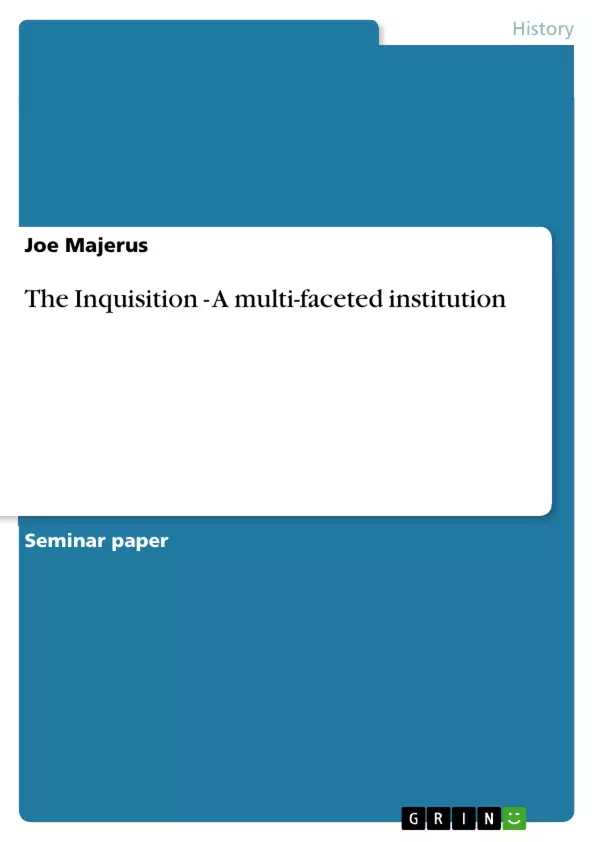A brief yet illuminating account of both the medieval and early modern Inquisition's various religious and judicial functions in western Europe.
Inhaltsverzeichnis (Table of Contents)
- Introduction
- The Medieval Inquisition
- The Spanish Inquisition
- The Portuguese Inquisition
- The Roman Inquisition
- Conclusion
Zielsetzung und Themenschwerpunkte (Objectives and Key Themes)
This work aims to explore the complex reality of the Inquisition, analyzing its historical development, institutional structure, and methods of operation. It seeks to provide a nuanced understanding of this institution, challenging popular misconceptions and highlighting its diverse facets.
- The evolution of the Inquisition from its medieval origins to its various manifestations in Spain, Portugal, and Rome.
- The diverse motivations and objectives of the Inquisition, including the suppression of heresy, the maintenance of Catholic unity, and the pursuit of political control.
- The specific practices employed by different Inquisitorial bodies, including trials, confessions, and punishment, as well as the use of torture and the role of the auto-de-fé.
- The impact of the Inquisition on different societies, particularly the persecution of Jewish converts (Conversos) and the rise of the Counter-Reformation.
- The historiography of the Inquisition and the persistent challenges in understanding its true nature and significance.
Zusammenfassung der Kapitel (Chapter Summaries)
- Introduction: This chapter introduces the concept of the Inquisition, defining its historical origins and its various manifestations across different geographical regions. It also highlights the key motivations and objectives of this institution, emphasizing its multifaceted nature.
- The Medieval Inquisition: This chapter focuses on the origins and development of the first Inquisition in the 12th and 13th centuries. It examines the key factors that led to its establishment, its organizational structure, and its methods of dealing with alleged heresies. The role of figures like Pope Gregory IX and the Dominicans is explored, as well as the use of torture and the administration of justice.
- The Spanish Inquisition: This chapter explores the unique context of the Spanish Inquisition, its origins in the aftermath of the Reconquista, and its focus on the persecution of Jewish converts (Conversos). It examines the procedures and methods employed by Spanish Inquisitors, including the use of torture and the auto-de-fé, and the impact of this institution on Spanish society.
- The Portuguese Inquisition: This chapter examines the Portuguese Inquisition, which shares similarities with its Spanish counterpart but focuses specifically on the persecution of Sephardic Jews. It explores the motivations behind its establishment and its methods of operation, highlighting its role in maintaining Catholic orthodoxy and enforcing conformity.
- The Roman Inquisition: This chapter discusses the Roman Inquisition, established in 1542 as a key instrument of the Counter-Reformation. It examines its structure, its role in combating Protestantism, and its impact on the spread of dissenting beliefs in Italy. It also addresses the popular misconception of the Roman Inquisition's role in persecuting witches.
Schlüsselwörter (Keywords)
The keywords central to this study include: Inquisition, heresy, Catholicism, Counter-Reformation, Conversos, auto-de-fé, torture, religious persecution, historical analysis, and institutional structures.
Ende der Leseprobe aus 8 Seiten
- nach oben
- Arbeit zitieren
- Joe Majerus (Autor:in), 2011, The Inquisition - A multi-faceted institution, München, GRIN Verlag, https://www.grin.com/document/201295
Blick ins Buch



